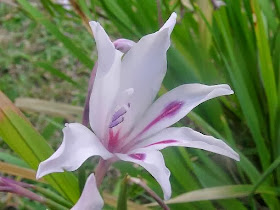Types of Flowers
Gladiolus Hybrid Nanus:
The nanus group of hybrids is commonly found in catalogs and garden centers labeled as "Butterfly Glads" or "Winter-hardy Glads". Both of these names fit this group well. For a group of hybrids derived from African species, they are surprisingly hardy (to USDA zone 4 when overwintered in the ground and can also be treated like the Grandiflora hybrids and dug each fall and replanted in the spring). Many of the hybrids found today were bred at the turn of the century, which is a testament to the disease resistance of this group. Although the exact parentage of these hybrids is mostly lost, we know that they are the result of crossing the summer and winter blooming species together. In fact, virtually all of them are actually first generation hybrids. We know this because they are sterile, with three sets of chromosomes (triploid) instead of the normal two sets (diploid) or the four sets found in the modern Grandiflora hybrids. Because odd sets of chromosomes cannot pair during the first division of meiosis, normal gamets cannot be formed. However, in gladiolus hybrids, it has been found that triploids do produce some gamets and that these typically have either 15, 30 or 45 chromosomes. These viable gametes typically form in the ovaries and thus the plants are pollen sterile. If the triploid plants are pollinated by pollen from a diploid (15n) or tetraploid (30n), some of the resulting seeds will be fertile tetraploids (2n=60). The fact that most nanus glads are triploids indicates that they derive from crosses with G. dalenii, a Summer blooming species with four sets of chromosomes (tetraploid), and some of the many Winter blooming, diploid species.
The nanus glads display a variety of colors and patterns, but most have conspicuous darts of color on the upper petals. This is in contrast to the blotch pattern in the modern Summer blooming glad hybrids, which is on the lower petals. However, this pattern of darts is very similar to that seen in G. carneus. The nanus glads come in white, pink, salmon and some varieties are nearly red. They have graceful spikes with fewer than 12 buds. Because of their grace and hardiness they are useful garden subjects, and are grown as cutfloers in Europe. Recently, breeders in Israel have produced a new series of hybrids by crossing modern Summer flowering hybrids with the Winter blooming species G. tristis. These have been produced for the cutflower trade and should be similar in growth habit and bloom season to the nanus cultivars.
















No comments:
Post a Comment